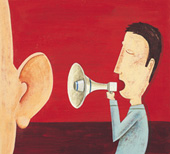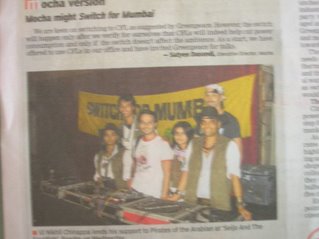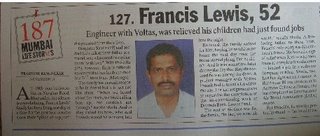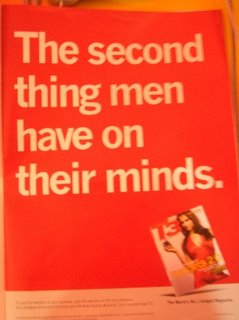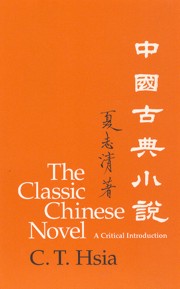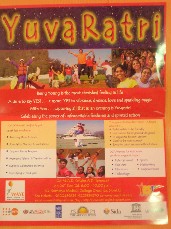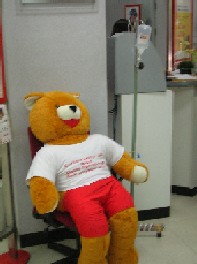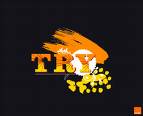
BBH is among the agencies that I admire more than I know about. It's more in the mindspace as it's India entry is the staple scoop of Brand Equity:-)
So, when my friend Gopal sent me this article, I was tempted to share with the wider world. Don't know if it's copyright infringement!
The article reproduced in entirety from Irelands Marketing Monthly...
Man of ideas - Interview by Michael Cullen
Mention the name John Hegarty and some of the best known TV campaigns ever spring to mind. He is the man who gave Levi's gravitas from the time Nick Kamen shocked onlookers in the launderette and a young Brad Pitt photographing with a curvacious brunette in the desert. Mention Audi and Hegarty's line Vorsprung durch technik follows.
For Hegarty, the business of advertising is simple, straightforward. It is about talented people coming together and having great ideas. Whether agency staff sit together or in separate rooms, whether they hang upside down from the ceiling or do away with desks and have bean bags, it is largely irrelevant. Great ideas, great ads maketh.
Relaxed, pragmatic and remarkably demure for a man who has scaled enviable creative heights, Hegarty knows adland intimately and appears content in himself. Diplomatic too. Speaking to him, one suspects that should the UN look towards Europe rather than the Far East for a replacement for Kofi Annan, Hegarty could be in with a shout.
John Bartle, Nigel Bogle and himself first got together in 1973 at TBWA. When asked what for him was the most important element in their 23-year partnership, Hegarty said: "Respect… respect for each others' skills. I think all three of us had that. No one tried to do somebody else's job." Bartle retired in 1999 but still keeps in contact.
'None of us is as good as all of us' became the BBH mantra. It came out of the fact that the three agency founders had differing skills; Bartle's was in planning, Bogle account management and Hegarty creative. While all three may have been handy at what they did, by combining their talents, they felt they could achieve something special.
"It was a genuine belief that this is a business that no one person is the ultimate boss," Hegarty said, "it's about a combination of skills working together. By constantly referring to that, you make everyone understand that's how they've got to do things."
Hegarty avoids using the word 'originality', leaving that feat to God alone.
'Original' prompts unease. He refers to a line he heard which says that 'originality is determined by the obscurity of your sources', a credo not unlike the one used to define plagiarism: 'There's not such thing as plagiarism, you only improve'. Anyway, freshness is the word Hegarty prefers to call on when describing something new and true in ads.
"There's a huge danger with lots of new technology around," Hegarty said. "There's fragmenting of media, the change of how people are consuming media and how they are more in control. They are going to determine when and what they're going to watch. That means advertisers have really got to think how they're going to communicate.
"But if do great things, people will watch them." While Hegarty hesitates to describe British advertising as the best there is anywhere, but "it is pretty good". The UK is lucky in having a perfect population size - not too big, 60 million people - and the market benefits hugely from having the non-advertising BBC, which sets standards.
"Anybody who says to me the market is the great leveller and the great decider, I kind of go, well… if you didn't have a public-funded broadcasting system, commercial TV in the UK would be even worse. One only to go to countries like the US to see the alterative and the way they've had to go to finance TV in a completely different manner.
"In the UK, there's a sense of irony. Humour's important as it's the enemy of authority and it's a great way of getting people to listen. Of course, it's subjective but as a creative person in advertising you either can do humour it or you can't."
BBH have always had a policy of not working for either a political party or a tobacco company. Hegarty believes that if you subscribe to one political ethos and it conflicts with another, it is hard, if not impossible, to work on such an account. But the agency has had approaches over the years, including when John Major became Conservative leader.
BBH was asked to meet with Chris Patten - a Tory Hegarty admires - but they chose not to do business. BBH does handle public information accounts, such as Barnardo's and anti-smoking campaigns. They are on the Central Office of Information (COI) roster.
While relatively conservative in his style of play, Hegarty admires Trevor Beattie, ex-TBWA and co-founder of Beattie McGuinness Bungay. Beattie has built reputations for clients and himself with clever PR stunts for the likes of fcuk. "Yeah," Hegarty said, "I think Beattie is a very talented guy. Do I like all his work? No."
"But he's good for our business. He's a fantastic spokesman. A lot of people didn't like fcuk but it wasn't talking to them. It was intended to annoy them. That's partly what made it successful. They got annoyed and other people went 'yeah!' It's a bit like drugs. The reason drugs are so popular is because they're banned. That's part of their allure."
BBH limits the agency showreel to current work. So when potential clients come knocking on their door, they get to see only ten commercials and a number of print campaigns. Despite having a collection of brilliant work in their archives, Hegarty does not believe in presenting golden oldies in new business pitches.
Why did BBH do the media deal with Leo Burnett? "We realised we needed more than one office," Hegarty said, "that everything could no longer be done out of London. That's a thing to learn, you don't get everything right straight off. To make it work, without having a global network, we knew we had to do a deal on media."
So they signed up with Starcom, giving Leo Burnett a 49 per cent share. BBH now has six agencies in all. Singapore was the first shop outside the UK and then came New York, Tokyo, Shanghai and Sao Paolo. While Hegarty tries not to do too much travelling, duty calls. Luckily, BBH is now the global agency for the £60m British Airways account.
"I don't like being one of those creative directors who comes in, looks at the work and says 'it's all shit' and flies out. Whatever you do, it's important you carry on working on actual pieces of business. It keeps you in touch with the reality of being an agency and running an account - you stay fresh, alert and alive to the problems out there."
Pressing matters on the BA account meant Hegarty had to leave Kinsale on the Saturday morning, thereby missing out on the festival banquet and winners show. "We were ready to press the button on certain things," he said. "The big idea was that passengers upgrade to BA, but things have to be in place and the airline has to be able to deliver on that."
The work is there, ready to go. But BBH has not concentrated more on giving them business advice rather than just ads. Security concerns at airports with queus a mile long and restrictions on what passengers are allowed to bring through in their hand luggage has also had a negative effect on getting plans off the ground.
Hegarty explains how Audi's Vorsprung durch Technik (Lead through Technology) came about. He was on a tour of the Audi plant in Germany and he noticed a sign on the wall with the infamous words. He noted them and put them to use. Since then, the phrase has found its way into pop culture and was used in the U2 song Zooropa and Blur's Parklife.
What type of career might Hegarty have pursued had he not become involved in advertising? "When I went to art school, I wanted to be a painter," he said. "But I was undoubtedly a rotten painter, which came as a shock. I love architecture and the idea of managing an environment and experience for people… a bit like advertising."
Having said that, he agrees with his colleague, Nigel Bogle, who recently suggested that advertising has become less influential. "Our business isn't good at promoting itself," he said. "It doesn't have a clear view of what it needs to do and it's very short-term in its vision. As far as clients are concerned, advertising isn't an industry which has stature."
WHIFF OF EXCITEMENT John Hegarty's agency, Bartle Bogle Hegarty, has created some magical campaigns for Lynx deodorant, like the 'Click' commercial with actor Ben Affleck.
Was advertising still paying the price for when there was a lot shysters in the business? "I think they still are and they always will be," Hegarty said. "One of the big problems with advertising is that you don't need any qualifications to be in it. Anybody can set up an agency tomorrow and spout all sorts of nonsense and get all sorts of headlines.
"That's one of the problems. It's one of the advantages too. Years ago, I was at a talk on new agencies. Geoff Howard-Spink was on the panel and a client in the audience asked him did he think it was appalling how much agencies earned, to which he replied: 'Listen, there are no barriers in this business, why don't you start an agency?'
Hegarty has harsh words for the trade press in the UK. "The suck up the nonsense which some people come out with," he said. "They don't really question it. No other industry would put up with. If architects, for example, were to do it, they'd be laughed at. But in our industry they are given column inches as they go about the way it's going to be…
"The trade press should expose them, not glorify them. It's like economists who make predictions and they review them at the end of the year as to what they said and what actually happened. But there's no accounting in advertising. They come out with absurd statements and the media don't come back and question them why it didn't work."
Aside from BBH, Hegarty is a great fan of the work done by Abbott Mead Vickers BBDO for The Economist. He says that every lesson anyone would want to understand about advertising is contained in that first ad, '"I never read The Economist" - Management Trainee, aged 42.' For him, that line by David Abbott is pure brilliance.
As far as some of the BBH accounts that have given him most satisfaction, one would be Phileas Fogg, the gourmet snacks brand sold to United Biscuits. Due to the fact that the ads centred on the Phileas Fogg factory up in Consett, Co Durham, UB could not close the plant and so the advertising had helped in keeping people in their jobs.
Some critics of BBH around Soho have suggested that the agency has allowed the creative standards slip at the expense of winning new business. Hegarty agrees that such remarks are not entirely unfair. The agency was obsessed with having great work and it is essential that they should always strive towards that, but it would be stupid for him to deny that they are altogether happy with where the work is just now.
"We've been very disappointed with some of the work over the last 18 months," he replied candidly. "But you get that playing at such a high level. A campaign comes to an end. Look at Sony Bravia… Fallon had that business for about four years before they created a great piece of work. It takes a long time and it's much more complicated.
"We're now working on Omo and Persil. You can't move it instantly. We've always said 'play the long game'. We've got some brilliant work coming through at the moment." While BBH is not a process-driven agency, neither do they believe in creative chaos. They are very buttoned down and work to a micro network globally.
Hegarty takes some satisfaction out of the fact that the agency was laughed at by rivals but now many people see the micro model as the way forward. BBH does not entertain speculative pitches but Hegarty is less committed when asked about whether or not clients should be charged for new business presentations.
"Agencies should do what they believe in doing," he said. "Personally, I think it would be better if we were paid but it would never work. There are too many people chasing too much work." On industry awards, Hegarty is not surprisingly broadly in favour of gongs. But he also concedes that they can be over-indulgent and there are far too many of them.
Agencies feel they have to enter a certain number of awards because if they don't, people start saying 'oh well, they're not entering awards any more'. So agencies are sort of forced into entering, whether they really choose to or not.
Hegarty believes it has always difficult to convince people generally of the value of advertising. Clients who understand advertising and use it to its best effect are the successful companies. The media marketplace is overcrowded, as it every market. Audi will not stop making cars just because the car market gets more competitive.
Getting back to the Audi slogan, Vorsprung durch Technik, again, research said they should not go with it as it would not work in the UK. But the client said "but we are German" and Audi (pronounced 'ow-dy' as in 'howdy') went with it.
BBH was in the news earlier this year for a dispute the agency got involved in with production houses over paying directors direct. It became about as BBH tried to explain to the production houses that agencies were under pressure from clients on cutting costs.
BBH felt they were better at negotiating than the production houses.
Hegarty puts the row down, which became a stand-off for a while, as "just one those things", where someone wakes up one morning feeling a bit miffed. The matter was resolved and it was agreed that BBH would negotiate with editors and they would work with the production houses to find editors which best suited the given project.
Was the action by BBH necessary? "No, it was completely out of hand. The issue wasn't really about editors, it was about agencies continually doing more of the work production houses do. My belief is that increasingly we will because we'll have to control it more. We're better at buying. Our agency is better at it than most production companies."
Advertising is not strictly speaking an art in Hegarty's mind. Rather it is where art meets commerce. Hundred of years from now anthropologists will look at commercials like the one for Heineken 'Water in Majorca' where you have a toffee-nosed public school type female woman being changed into a Cockney lass and dissecting it in so many ways.
That commercial reflected the British obsession with class. Nowadays, the emphasis in advertising is in sport, often dubbed 'the new religion' and advertising measures that. Hegarty recalls a scene from Steven Spielberg's Close Encounters where the aliens came down to earth and Francois Truffaut said: "I think they want these people to come."
They sought fun, to play. We are moving towards a culture that wants to play and advertising is part of the entertainment industry. On media speculation that Levi's and BBH may about to part company after 24 years, Hegarty said that the client was upset by the rumours that were put about and denied they had any currency whatsoever.
One client which did exit BBH during the summer was the £50m Sony Ericsson global account. The split followed a decision by Sony Ericsson to buy a brand strategy from Wolff Olins with which BBH fundamentally disagreed. They told the client that they could not possibly execute it. Saatchi & Saatchi has since won the global business.
The Wolff Olins strategy, which was presented to BBH by the mobile phone marketer as a fait accompli, was based on the 'I Love New York' idea, but with the Sony Ericsson logo replacing the heart shape, which, of course, itself was originally substituted for the word 'Love'. Instead of New York, words like 'music' and 'photography' will feature.
While these days are among the more difficult times to be in advertising, they are also one of the most exciting periods Hegarty has yet encountered. After all the hype and misplaced promises, the internet stands as a strong force in communications in the future.
Hegarty has a lot of friends in adland, but he has also developed new ties by investing in a vineyard in France. Having been born and bred in London, his friends suggested that he should buy somewhere in the country. He had no interest in somewhere temporary where you visit for a few weeks, lock up again and return home, so he bought a vineyard.
How does Hegarty think he is perceived in advertising? "I think they wonder why I still go on," he said with a wry smile. Andy Berlin on Red Cell referred to him as "a creative entrepreneur". Somewhat unsure about its meaning, Hegarty just says he believes he has an understanding of client needs and he likes to makes "businesses better".
Now 62, Hegarty still enjoys going to work each day. Advertising is like a drug in that it is enjoyable. He quotes the line by Jerry de Femina, who said "advertising is the best fun you can have with your clothes on". The long, liquid lunch may happen less often now but that matters a jot to Hegarty. Fun means using great ideas to become great ads.
Guys, if you find interesting articles on the advertising stalwarts, do send it to me. Occasionally, I would love posting them on IndiAdRant...
Cheerios
